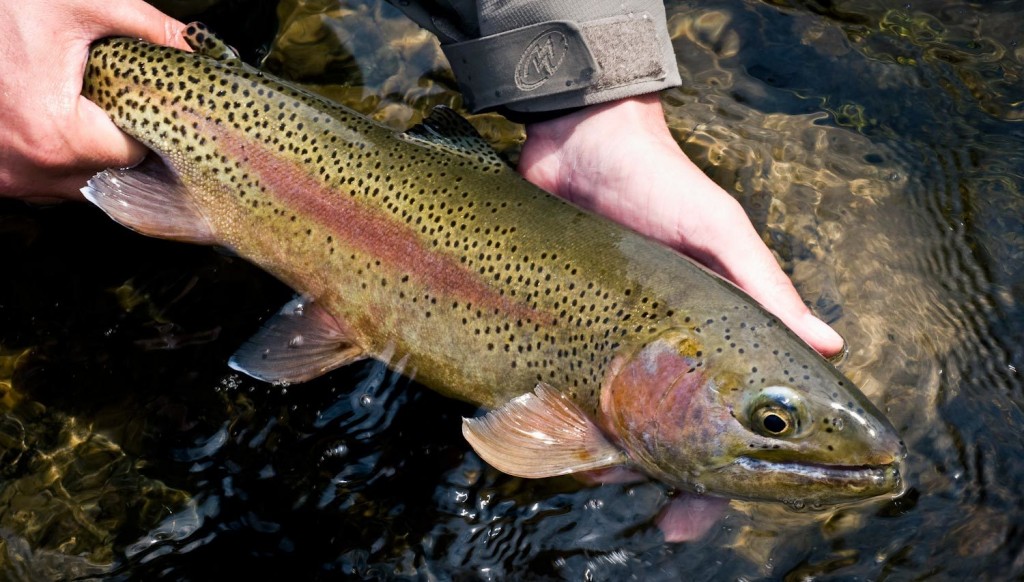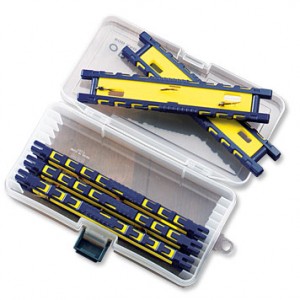
Having a completely different pre-rigged tandem nymph rig ready helped me catch this beauty. Photo: Louis Cahill
Changing out flies on the water takes time but is often necessary to catch trout consistently all day.
Keeping a pre-rigged tandem nymph rig ready to go, will allow you to quickly change out your flies from one hole to the next and save you critical time when your fishing time is limited. They’re great to have when you find your hot fly has turned cold, when you break your rig off on a snag or find yourself with a nasty tangled mess. Let’s face it, we often find ourselves in question on the water, particularly in the first hour after we’ve wet our line. It can take some time to figure out what the trout want for the day, and by having a couple different pre-rigged tandem nymph rigs on hand, you’ll find it much more efficient to try multiple fly patterns and rigs out, and that should help you dial-in quicker and start catching trout.
Sometimes the tandem nymph rig you just caught trout with in the hole downstream, may fail to get the attention of the trout in the next hole you fish. This isn’t always the case, but sometimes for sure. In fact, this happened to me just the other day. My client had landed a fish out of the first three holes we fished in the morning with a woolly bugger lead fly and a micro san juan worm dropper. As my client worked the fourth hole of the day, the bites abruptly stopped, despite him making several great presentations and drifts. Knowing there were fish in the hole, I snipped off the rig and tied on one of my different pre-rigged nymph rigs. First cast, my client landed a trout, and he went on to catch another fish after that. If I would have stuck with the first rig, thinking the flies were fine because they worked in the previous holes, we probably wouldn’t have landed those two fish. There is no doubt there are times when trout will key in on a specific aquatic insect and become selective feeders. However, some days, when there isn’t a hatch or specific food source they are keying in on, I think trout often create their own specific food menu for the day. When this is the case, and you’re not having success, often all you need to do to get trout to bite, is show them something different. Humans are no different. If we eat the same thing for lunch a couple days in a row, we’re ready for a change.
So before my guide trips these days, I’ve got in the routine of tying up a few different tandem nymph rig combinations, and stow them in either my pack foam patch or organize them neatly in my Orvis Dropper Rig Fly Box. I’ll have one big fly and bright attractor nymph rig, one heavy medium-sized lead fly nymph with a soft-hackle rig and last, I’ll have a small tungsten nymph with a tiny baetis or midge dropper rig. Between these three rigs, I’ll usually find one that works for the water I’m fly fishing. Give this tip a try next time you’re out trout fishing.
Update: Orvis is Currently Selling the Dropper Fly Box. Click the link or photo above to visit the product page on the Orvis website.
Keep it Reel,
Kent Klewein Gink & Gasoline www.ginkandgasoline.com hookups@ginkandgasoline.com Sign Up For Our Weekly Newsletter!

I use an Orvis Dropper Rig Fly Box, but it’s set up with tandem dry flies for lake fishing. More specifically, a dark fly and a light colored fly a foot apart. I can see the dark fly against a steel grey surface, and the light fly against the dark green background of pine trees. And, since I can always see one fly, I know where the second fly is sitting.
I do basically the same thing, but I use a much less expensive lindy rigger (snelled hook holder, worm harness holder). I keep a few standby rigs set up, but I also use it to store used rigs I cut off when changing to a new rig. It’s a great time saver, quickly wrapping up a used rig, rather than cutting off each individual fly, and I don’t have to deal with small used pieces of tippet!
Then when I get home, after the flies dry, I can remove the flies (if the rigs are not one of my standard “keeper” rigs) from the rig and insert them back into their proper fly boxes, while also properly disposing of used tippet.
This is the one I use. It fits great in the big pocket of my Orvis Guide Sling Pack:
http://www.amazon.com/Lindy-AC100-Rigger-1-cd/dp/B001447T4Q
Great advice, Kent (hopefully Orvis is giving you a commission on this, because I went straight to the link and ordered a box!). What knot do you recommend using to tie the pre-tied rig to leader?
whats wrong with taking a few minute breather, observing what is going on on the river, re assessing your strategy, and re rigging? i can see having a dry fly rod and a nymph rod but having 2 nymph rigs seems silly.
Nothing inherently “wrong” with taking the time, but there are also many different scenarios when having some pre-tied rigs at the ready is advantageous. For instance, I am far sighted, and have difficulty tying small knots, especially in low light. As well, when fishing in the winter, it is not a lot of fun having my hands exposed to the freezing cold for extended periods while trying to tie up multi fly rigs. Having pre-tied rigs is meant to be a tip. Not a rule.
And finally, if you knew anything about my mom, you’d change your screen name. She isn’t a terribly pleasant person.
“your mom,” you clearly didn’t actually read the article, read it again before you call it silly…what’s wrong with taking a few minutes to read the whole post?
“Taking a breather” is very different on stillwater compared to moving water. The fish are always moving rather than sitting on a feeding site. You run a trolling motor, or have oars at the ready, to chase the fish as they move about. If you like sitting still, while trying to tie on a #16-#18 with 77 year-old eyes, then a second fly, while the fish are happily slurping and swimming away from you, have at it. Me, I like pre-tied rigs.
Came across the Orvis Dropper box a few years ago. I use it for double nymph riggings for lake trolling on a sinking line and same for river fly fishing. For me, it saves a lot of time. Seems like I’m never speedy tying on the dropper knot.
Good tip Kent. You guys have me hooked to your site with all of the practical info. I have actually been rigging about 8 rigs and placing them on the rigging station on the inside of my chestpack cover for years. Prerigging has definitely helped with catching more fish and increasing efficiency. It worked awesome, but I would occasionally get a knot in a rig if I wasn’t careful. This makes total sense and no more knots. I think I might do the Lindy that John was talking about from Amazon, it looks like it would suit my needs a little better. Thanks again!